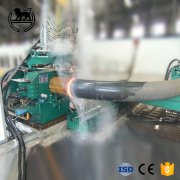Chinese | English

Skype: zhiguang.wu
Email:15230713671@163.com
Address: North Mengcun Industrial Park, Mengcun Hui Autonomous County, Cangzhou, Hebei.
The process of medium frequency pipe bending machine is simp
Medium frequency pipe bending machine is a commonly used equipment for processing metal pipes, mainly used to make various curved shapes of pipes, widely used in construction, petrochemical, energy and other fields. The process of medium frequency pipe bender is relatively simple, but some key steps need to be paid attention to. The process of medium frequency pipe bender will be described in detail below.
1. Material preparation
Before processing begins, the required metal piping materials need to be prepared. Choosing the right pipe material is crucial to the processing quality and finished product effect, and the materials commonly used include carbon steel, stainless steel, aluminum alloy and so on. Factors such as the strength, corrosion resistance and use environment of the pipe should be considered in the selection.
2. Design drawings
According to the processing requirements, draw the pipeline design drawings. The design drawings include the length, Angle, radius of curvature and other parameters of the pipe, as well as the necessary marking and dimensional requirements. Design drawings are an important basis in the processing process and need to ensure accuracy.
3. Debugging of pipe bender

Before the formal processing, the pipe bending machine needs to be debugged. Ensure that the parameters and functions of the bending machine are normal, such as pneumatic system, hydraulic system, etc. At the same time, it is also necessary to adjust and calibrate the machine according to the required bending Angle to ensure that the processed pipe meets the requirements.
4. Heat treatment
During processing, metal pipes need to be heated to increase their plasticity and curvature. Commonly used heating methods include flame heating, resistance heating and so on. Depending on the material, the heating temperature and time will also be different, and it needs to be adjusted according to the actual situation.
5. Bending processing
The heated metal pipe is put into the work table of the pipe bender, and the bending Angle and curvature radius are controlled by adjusting the cylinder and hydraulic system of the machine. In the processing process, it is necessary to pay attention to the deformation and rebound of the pipeline, and adjust and correct it in time to ensure that the processed pipeline meets the design requirements.
6. Cooling treatment
After the bending process is completed, the metal pipe needs to be cooled to remove the internal stress and restore its original physical properties. The cooling method can be natural cooling or water cooling, and the appropriate cooling method is selected according to the characteristics of the material.
7. Check and trim
The cooled pipe needs to be inspected, including appearance quality, dimensional accuracy, bending Angle and so on. If there is a non-conforming situation, it needs to be repaired and corrected until it meets the requirements.
8. Surface treatment
Finally, the surface treatment of the finished pipeline is carried out to improve its surface quality and corrosion resistance. Commonly used surface treatment methods include spraying, galvanizing, polishing, etc., according to the actual needs to choose the appropriate method.
Although the process is relatively simple, it needs to be rigorous and meticulous in each link to ensure that the quality of the processed pipeline meets the requirements. Medium frequency pipe bending machine is widely used, which provides important support for the development of all walks of life.
For more information about medium frequency pipe bending machine, please pay attention to our website:http://www.xhxhhsl.com/
